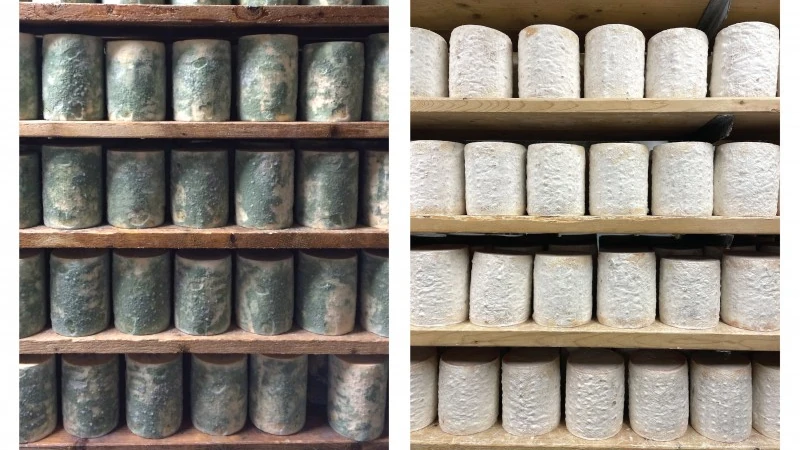
In a surprising twist of scientific discovery, the evolution of fungi on cheese rinds is revealing crucial insights into genetic adaptation, with implications that extend from food production to health. This unexpected breakthrough was observed by Benjamin Wolfe, an associate professor of biology, and his team, as they studied the transformation of cheese fungi in a Vermont cheese cave.
The journey began in 2016 when Wolfe, under the guise of a personal trip, collected samples of Bayley Hazen Blue cheese from Jasper Hill Farm. These samples, stored in his lab, became the foundation for a fascinating study when graduate student Nicolas Louw noticed a significant change in the fungi’s coloration during a routine visit to the cheese caves. The once leafy green fungus had turned chalk white, indicating a possible evolutionary adaptation.
Unveiling Evolution in Cheese Caves
This discovery, detailed in the journal Current Biology, highlights how microbes can evolve in situ, much like antibiotic-resistant bacteria or pathogenic organisms. “Microbes evolve. We know that from antibiotic resistance evolution, we know that from pathogen evolution, but we don’t usually see it happening at a specific place over time in a natural setting,” Wolfe explained.
The implications of this research are significant. Fungal adaptation is a major concern in agriculture, where it contributes to the loss of approximately 20% of staple crops pre-harvest and another 20% post-harvest due to fungal rot. Understanding these mechanisms could be key to enhancing food security and reducing waste.
The Genetic Mechanisms Behind Fungal Change
The transformation observed in the Jasper Hill cheese was traced back to a gene called alb1, responsible for melanin production. This pigment acts as a protective layer against UV damage, but in the dark environment of a cheese cave, its absence allows fungi to conserve energy. This process, known as “relaxed selection,” is common in organisms adapting to low-light conditions, such as cave fish and salamanders.
Jackson Larlee, a student in Wolfe’s microbiology course, identified that the color change was due to multiple independent mutations. These included point mutations and the insertion of transposable elements, which disrupted the expression of the alb1 gene. This genetic flexibility enabled the fungi to thrive in their unique environment.
“We found that the change was not just one mutation that swept through the whole colony, but the color shift came about through many types of mutations independently,” said Louw.
Broader Implications for Health and Industry
The findings have potential applications beyond cheese. Aspergillus fungi, related to Penicillium, are common in various environments and can cause severe health issues in humans. Understanding their adaptation could lead to better prevention strategies for infections.
Meanwhile, Wolfe’s lab is collaborating with Jasper Hill Farm to explore the culinary benefits of these evolutionary changes. By inoculating fresh brie with the novel white mold, they have created a cheese with a unique flavor profile, described as “slightly nuttier and less funky” by Louw. This innovation could pave the way for new cheese varieties with enhanced taste and texture.
“Seeing wild molds evolve right before our eyes over a period of a few years helps us think that we can develop a robust domestication process, to create new genetic diversity and tap into that for cheesemaking,” said Wolfe.
Looking Ahead
The research conducted by Wolfe and his team underscores the dynamic nature of microbial life and its potential impact on various sectors. As they continue to refine their cheese-making techniques, the broader scientific community may gain valuable insights into microbial adaptation and its applications in agriculture and health.
Tufts University, where this research is based, is renowned for its commitment to academic excellence and innovative research. The institution’s collaborative environment fosters breakthroughs like this, with implications that resonate far beyond the cheese caves of Vermont.







